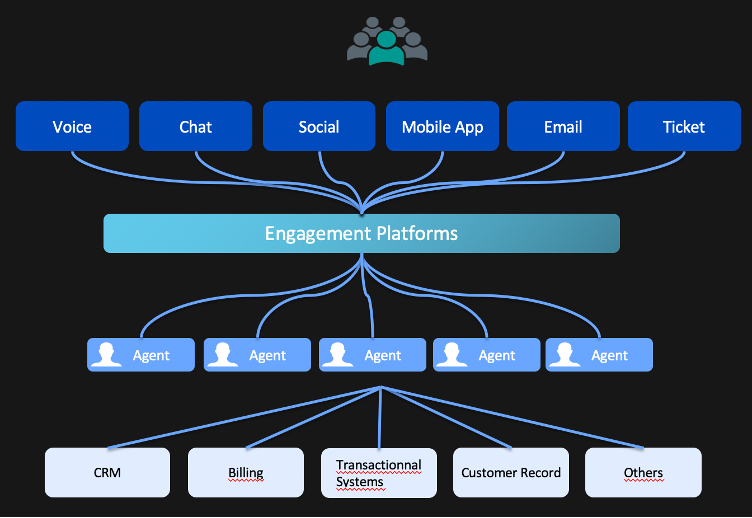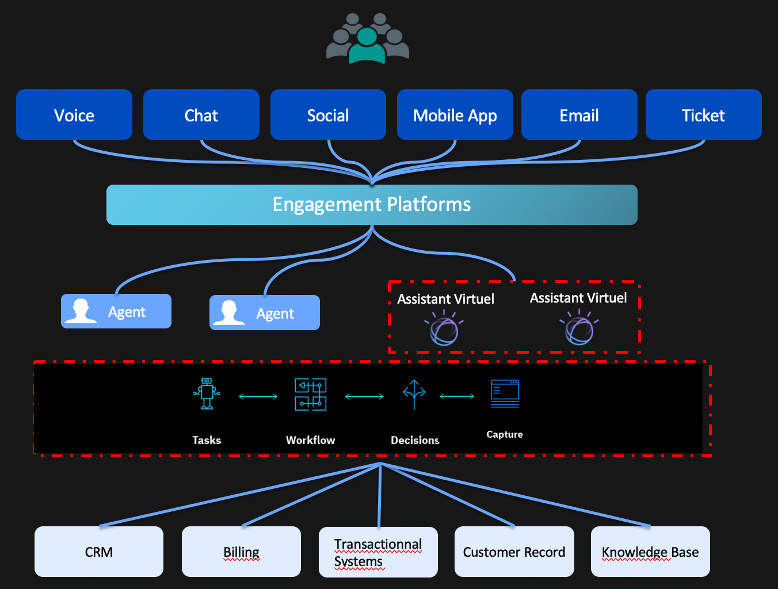For many companies, their call center is the main point of contact for their customers. Therefore, it is very important for them to propose an exceptional customer experience and this poses a great challenge! I’m sure that you can all recount negative encounters that you have experienced when contacting an organization’s call center, whether it was for renewing your insurance, purchasing a cell phone, or getting support for a problem with your Internet connection.
In most call centers, engagement models are classic and have several shortcomings:
- Very long response time – I’m talking about the famous “Your call is important to us…” or “This waiting time is involuntary on our part…”.
- Fragmented customer contact points – How often have you had to repeat your problem or request to different people?
- Did you know that only 69% of requests are resolved directly? – Why do front-line agents never have the authority or knowledge to solve our problem?
- Non-personalized real-time experience – How many times have you been put on hold because the person needs to “pull your file” when they have already asked for your date of birth, account number and “PIN”?
In addition to these shortcomings that often leave customers with a strange aftertaste in their mouths, companies need to reduce customer support costs in order to remain competitive. The problem with a traditional model is that the lower the cost, the more the customer will suffer. Several solutions have been considered in the past (voice recognition, sending the call center abroad, etc.) without much success.
How to find a sustainable solution? This is where new automation technologies and artificial intelligence come in to help you!
Transforming the engagement model with intelligent automation technologies
The figure below shows a typical engagement model for most large call centers.

Legacy Call Center Model
In this model, an engagement platform is often put in place to provide a single point of contact for agents regardless of the communication channel chosen by the customer. Examples of such platforms are Zendesk or Salesforce. This model has some challenges and agents quickly become the bottleneck:
- Since it is impossible to clone an agent on demand, the call center’s processing capacity is a function of the number of agents available.
- Since not all agents have the same knowledge, the level of service differs depending which agent answers you.
- Access to “back office” systems is manual and often slow, resulting in customers being put on hold for long minutes.
How can these three problems be corrected? Some would say it takes a virtual assistant. While it is the case, it is only part of the solution. The complete solution requires the implementation of a cognitive engagement platform where artificial intelligence and intelligent automation technologies will work to replace the agent when it is useful and augment it in other situations.
The following diagram schematizes the concept of the cognitive engagement platform for a call center.

Cognitive Engagement Platform
How does it work?
In cognitive mode, the platform will automatically assign the request to a virtual agent who will initiate a process, a task, or a transfer to a human agent as needed. In addition, a business rule engine allows call center management to dynamically modify agent (and process) behavior. Finally, a case management / business process management engine must be in the back and muse have a “low code” approach in order to allow the modification or creation of process applications quickly. This engine also makes it easier to manage the interaction between the process participants and provides a unified interface for access to back-end systems.
In fact, there are 6 proven use cases for the usage of chatbot & AI in a call center context. Stay tuned as I will be describing them in an upcoming post.
Does it really work?
According to the 2019 BenchmarkPortal Contact Center report :
- An agent receives an average of 3,837 calls per year.
- An agent will spend an average of 20 hours on repetitive tasks per month.
- The cost per call to a call center is $14.30 CAD.
This kind of project may seem complex, but it’s often simpler than you think. With technologies such as IBM Watson and IBM Digital Business Automation and an agile approach, it is possible to deploy a minimum viable product for less than $150k…so the ROI is almost in real-time.
If you are interested in the subject of cognitive call center and have any questions, do not hesitate to contact us.




